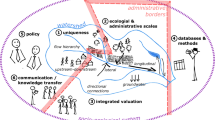Abstract
Ecology and culture comprise interacting components of landscapes. Understanding the integrative nature of the landscape is essential to establish methods for sustainable management. This research takes as a unifying theme the idea that ecological and cultural issues can be incorporated through management. As a first step in developing integrative management strategies, information must be collected that compares and contrasts ecological and cultural issues to identify their areas of intersection. Specifically how can local cultural knowledge enable water resource management that reflects cultural and ecological values? This research examines Native American cultural knowledge for setting water resource management priorities in the Wind River Indian Reservation in central Wyoming. A cross-cultural approach is adopted to assess the relationship between indigenous cultural knowledge and Euro-American perspectives through a comparative examination of the Wind River Water Code and Wyoming Water Law. This research indicates that cultural perspectives provide a rich arena in which to examine management issues. Understanding and identifying cultural practices may be an important first step in collaborative resource management between different cultural groups to prevent conflict and lengthy resolution in court.



Similar content being viewed by others
Literature Cited
L. Burton (1991, 174 pp) American Indian water rights and the limits of the law University Press of Kansas Lawrence, Kansas
Cashman, K. 1991. Systems of knowledge as systems of domination: The limitations of established meaning. Agriculture and Human Values Winter–Spring:49–58.
E. Checchio B. Colby (1993) Indian water rights: Negotiating the future The University of Arizona Press Tucson, Arizona
W. C. Clark (1990) ArticleTitleLearning from the past: Traditional knowledge and sustainable development The Contemporary Pacific 2(2 233–252
S. E. Clyde (1989) ArticleTitleAdapting to the changing demand for water use through continued refinement of the prior appropriation doctrine: an alternative approach to wholesale reallocation Natural Resources Journal 29(2 435–455
A. B. Cunningham (1991) ArticleTitleIndigenous knowledge and biodiversity: global commons or regional heritage Cultural Survival Quarterly 15(3 4–8
B. R. DeWalt (1994) ArticleTitleUsing indigenous knowledge to improve agriculture and natural resources management Human Organization 53(2 123–131
Flanagan, C. 2000. Culturally specific information in water and river corridor management: The Wind River Indian reservation, Wyoming. Unpublished master’s thesis, Colorado State University.
J. L. Huffman (1992) ArticleTitleAn exploratory essay on Native Americans and environmentalism University of Colorado Law Review 63(4 901–920 Occurrence Handle11652222
Laituri, M. 2002. Ensuring access to GIS for marginal populations. In W. J. Craig, T. M. Howard and D. Weiner (eds.). Community Participation and Geographic Information Systems. Taylor & Francis, London, pp 270–282
Laituri, M., and L. E. Harvey. 1995. Bridging the space between indigenous ecological knowledge and New Zealand conservation management using GIS. In J. Craig (ed.). Nature Conservation: The Role of Networks. Surrey Beatty and Sons, Chipping Norton, New South Wales, Australia
A. Lalonde G. Morin-Labatut (1995) ArticleTitleIndigenous knowledge, innovation and sustainable development: An information sciences perspective Scandinavian Journal of Development Alternatives 14(1/2 206–221
J. A. McNeely (1993) People and protected areas: partners in prosperity E. Kemf (Eds) The law of the mother Sierra Club Books San Francisco, California 249–258
S. Micheals M. Laituri (1999) ArticleTitleShaping sustainable management: the New Zealand experience of mediating exogenous and indigenous forces Sustainable Development. 7(2 77–86 Occurrence Handle10.1002/(SICI)1099-1719(199905)7:2<77::AID-SD104>3.0.CO;2-2
N. Roht-Arriaza (1996) ArticleTitleOf seeds and shamans Michigan Journal of International Law 17 918–965
D. Ruppert (1996) ArticleTitleIntellectual property rights and environmental planning Landscape and Urban Planning 36 117–123 Occurrence Handle10.1016/S0169-2046(96)00336-2
S. R. Sterling (1990) Towards an ecological world-view J. Engel J. Engel (Eds) Ethics of environment and development: Global challenge and international response Belhaven Press London 77–86
University of Wyoming. 1996. Water quality study of the Big Wind River below Bull Lake Dam. Unpublished study sponsored by the Wind River Water Quality Council.
C. F. Wilkinson (1992) Crossing the Next Meridan Island Press Washington, D.C.
Wind River Tribes. 1991. Wind River Water Code. Wind River Statutes, Chapter 8.
Wyoming Division of Fish and Wildlife. 1993. The effects of increased sedimentation on fisheries habitat in the Big Wind River below Bull Lake Dam. Unpublished study sponsored by the Wind River Water Quality Council.
Wyoming State Legislature. 1998. Title 41 (Water) of the Wyoming State Statutes.
Acknowledgments
Thanks are given to all the Shoshone and Arapaho tribal elders and members who participated in the interview process. A great deal of thanks goes out to Mr. Wes Martel for his assistance in this research project. He coordinated tribal meetings with the tribes, sponsored introductions to tribal government councils and the tribal community, and provided insight into the past and present resource management concerns faced on the Wind River Reservation. Mr. Don Aragon, Coordinator of the Wind River Environmental Quality Council, provided information associated with tribal water and natural resource management programs. Additional thanks are given to Merl Haas, Theresa White, and the Addison family for their hospitality and their invitations to participate in tribal ceremonies. Much appreciation is expressed for the detailed and helpful anonymous reviews of a previous draft of this manuscript.
Author information
Authors and Affiliations
Additional information
Published online
Rights and permissions
About this article
Cite this article
Flanagan, C., Laituri, M. Local Cultural Knowledge and Water Resource Management: The Wind River Indian Reservation. Environmental Management 33, 262–270 (2004). https://doi.org/10.1007/s00267-003-2894-9
Published:
Issue Date:
DOI: https://doi.org/10.1007/s00267-003-2894-9




